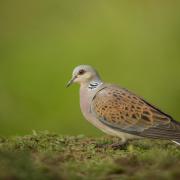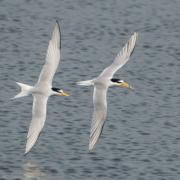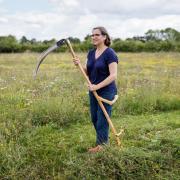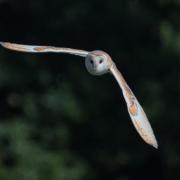The moon in June sheds subtle light on a wealth of nocturnal wildlife wonders. John Grant urges you to go out on the prowl
The moon in June sheds subtle light on a wealth of nocturnal wildlife wonders. John Grant urges you to go out on the prowl
THE lazy, hazy days of a Suffolk summer are here – but what about those hot summer nights? For the wildlife-watcher, and more importantly, the teeming millions of wild things we share our county with, from the tiniest invertebrate to the mighty red deer, the going about of our daily business does not cease when the sun goes down. Far from it. For us and our fellow creatures there just don’t seem to be enough hours in the day during June. Twenty-four measly hours? Nowhere near enough.When darkness descends out in the wilds of Suffolk after a day in June spent watching birds or butterflies or any of the myriad attention-grabbing, awe-inspiring aspects of our little corner of the globe, we dare not slumber too soon. If we do we will miss a magical moonlit world. A world in which we may not be able to actually see all that is going on out there but we can certainly hear, smell and – gloriously – experience it.There’s a sensory symphony awaiting anyone who ventures out into the countryside at dusk in June. For me, the richest experience is out on a Suffolk heath – maybe any one of the coastal Sandlings such as at Hollesley, Blaxhall, Aldringham, Dunwich or Westleton, or in the Breckland wilds of, say Cavenham or Berners Heath.Choose a still, balmy night when a silvery moon subtly illuminates the scene. Be quiet. Dead quiet. Just stand out on the heath with not so much as the slightest rustle or movement. Perfectly still, perfectly quiet. And listen. Intently. Cast aside any extraneous thought that may be nagging away in your head and listen. Really, really listen. Immerse yourself in the dusk. Even if you don’t hear anything, the experience is rewardingly relaxing. But the chances are you will hear plenty. And it’s not even essential to identify all the sounds. Just enjoy them.With luck you will hear the most famous of all heathland sounds. A dry, mechanical churring that changes pitch occasionally. Nightjar! Mysterious. Steeped in folklore. Accused by our forefathers of sucking milk from goats under cover of darkness. Hardly ever seen by day, only a little more commonly seen as a brief, falcon-like silhouette as it adeptly hunts aerial insects over the heather and among the sparse tree cover at the heathland edge. Does nature watching in Suffolk get much better than this? I think not.And it might not just be the moon that casts a glow over this magical place. Look down at your feet. All around you, and dotted like little green fairy lights across the heath, may be one of Suffolk’s most heart-warming spectacles. A display of glow worms. Worms, glowing? Yes – and no. Glow they most certainly do. And surprisingly brightly. But they are not worms. They are beetles that rejoice in the scientific name Lampyris noctiluca – big clue in both parts of the moniker. Usually only the wingless females glow strongly. They are trying to attract a flying male.Apparently a molecule called, somewhat disturbingly, luciferin is being oxydised to produce oxyluciferin. I am no scientist though and whether or not the females succeed in “pulling,” the mechanics of what they are doing rather passes me by. I prefer to disregard the chemistry and simply let the little creatures attract me, fascinate me and enthral me – and a June evening is one of the very best times to observe them.Away from the fairy-lit heath, almost any tract of wild land can captivate after dusk – our barn owl population thankfully now seem to be recovering and the widespread tawny and little owls are always likely to be encountered. And one mammal, too. Badger. Time was when these mainly nocturnal and infuriatingly much-maligned animals seemed to be extremely rare east of the A12, but not any more. Now their geographic spread across the county appears more complete. Sadly, the evidence for this conclusion is as depressing as the conclusion itself is uplifting. Roadside corpses. Many more of them. Well, at least the presence of a flattened badger beside a road in east Suffolk means the species is present. We can only hope that we are not perpetrating too much carnage and that the badger’s recent apparent range expansion is long-term and we may more often see live incarnations of the species during our moonlit ramblings.Of course, after-dark excursions can follow highly rewarding daylight expeditions through Suffolk and the botanists among us particularly have plenty to look down about, if you see what I mean!Suffolk Wildlife Trust veteran Peter Lawson tells me a look along our county’s hedges at this time of year can reveal a “glory of June” – the festoons of delicate pale pink and white wild dog roses. Here and there, often planted in the east along the banks of fairly recent bypasses at Wangford and Saxmundham on the A12, are deep pink sweet briars, whose foliage gives a delightful fruity smell when crushed. Late in the month the white field roses appear, with their long, arching, blue green stems.In old meadows, churchyards and road verges, the white oxeye daises often bloom en masse, while late in the month bright pyramidal orchids can be found among the longer grasses on boulder clay soils, occasionally in large numbers, as beside the A14 road near Claydon.Bee orchids open their fascinating insect-like flowers late in June, sometimes on recently exposed clay verges, following road widening. Do examine them closely when you can, as they often do not flower in the same place the following year. The flower really resembles a bumble bee and the idea is that real bees will try to mate with it and thus unwittingly cross pollinate it.So, it is clear that the busy nature of May referred to in last month’s Naturewatch is replaced by still more wonders. The ugly Americanism “24-7” springs to mind – there really is no time to switch off from Suffolk’s wildlife. Sleep? No chance. Live June to the full. We are, as they say, dead for a long time.
Now's the time to see...
ON THE BEACH: June is the time when holidaymakers begin to invade our beaches. As welcome as they may be we can but hope they take care to respect our beach flora for it is a scarce, nationally important and delightful feature to behold. Our coastal shingle banks and dunes are home to sea pea which will be blooming now, while the large cabbage-like sea kale has concentrations at the Suffolk Wildlife Trust’s Landguard reserve at Felixstowe, and at Orfordness.


























